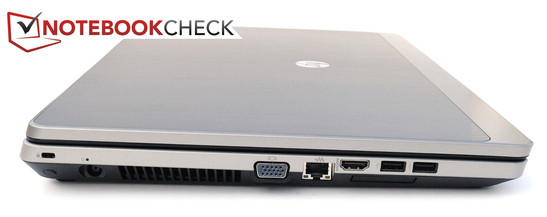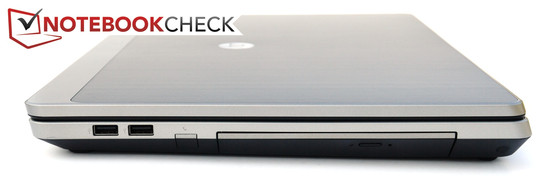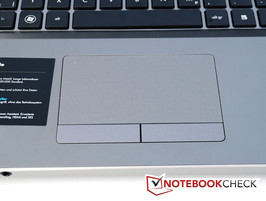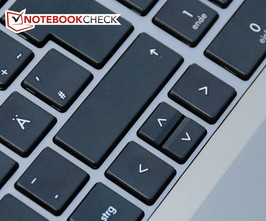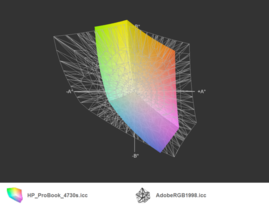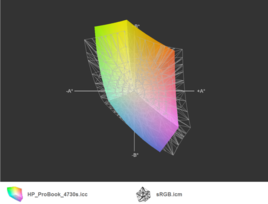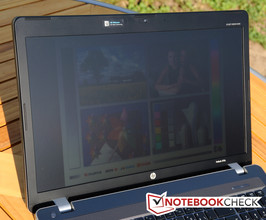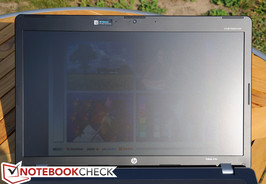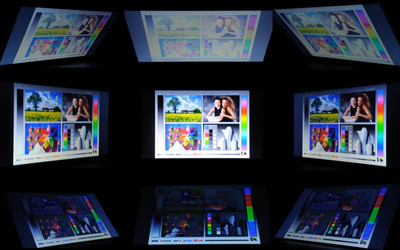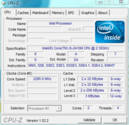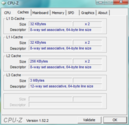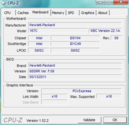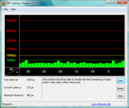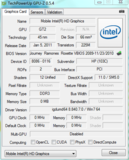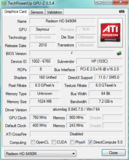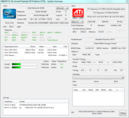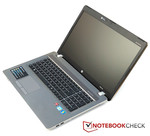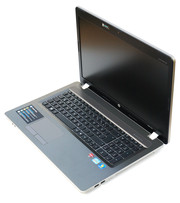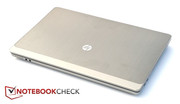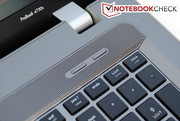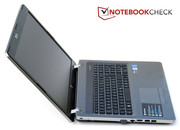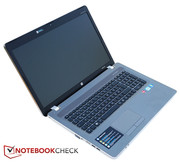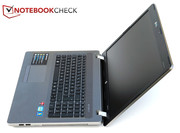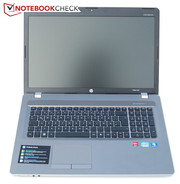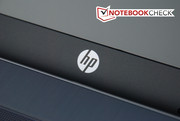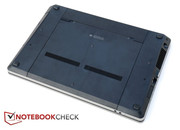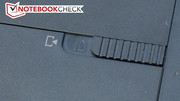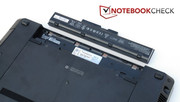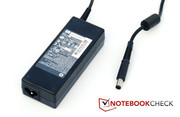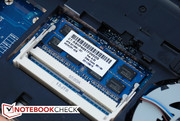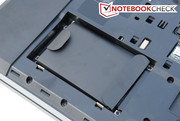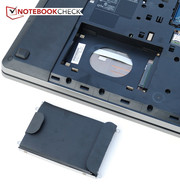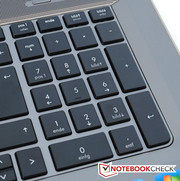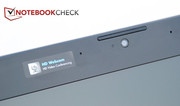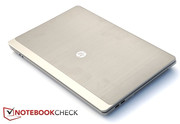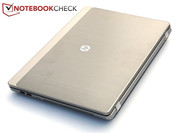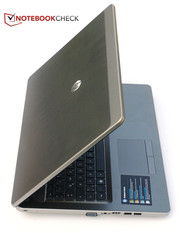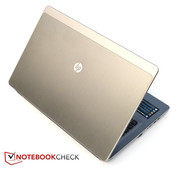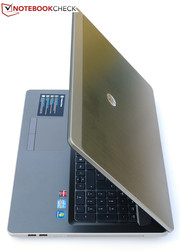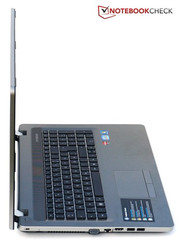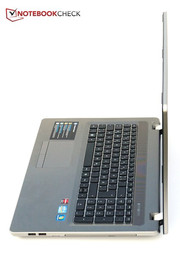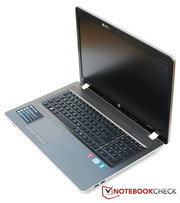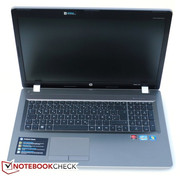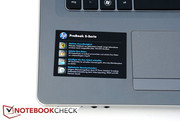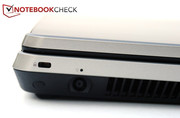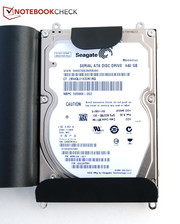Review HP ProBook 4730s-LH335EA/LH343EA Notebook

The HP ProBook 4730s is the next model on from the 4720s, and the larger brother of the HP ProBook 4530s which we have already reviewed.
HP’s ProBook series is actually a business range, intended to appeal to the demanding users in the upper price segment. But the ProBook series 4 machines already started moving in the direction of the consumer market with the 4720s, opting for high-gloss surfaces and brushed aluminium. The latest model, the 4730s, is now almost entirely targeted at consumers who would like to own a well-built, classy-looking notebook. The glossy surfaces may have disappeared again, but the ProBook is lacking in features that would attract the interest of business customers.
Also in terms of its price, the notebook is targeted at private customers and self-employed business customers, and can be bought for around 600 Euros.
At present HP is selling the notebook in a variety of different configurations. Our model is the ProBook 30s-LH335EA (identical to the ProBook 4730s-LH343EA), which is equipped with an Intel Core i5-2410M and an AMD Radeon HD 6490M graphics card.
Case
The HP ProBook 4730s has been completely redesigned, and now looks very different to its predecessor the ProBook 4720s. Whereas the older 17-inch model still had high-gloss surfaces, you will find only matt plastic or brushed aluminium surfaces on the ProBook 4730s. At the back, the notebook’s height is 43 mm, which tapers down to 32 mm at the front. The display lid and the upper side of the base unit are both fitted with aluminium brushed in straight lines. The laptop’s underside and screen edging are made of a matt black plastic. The build quality of the case as a whole is good.
The base unit is very robust. It does not give way to concentrated pressure in one spot, nor can it be twisted as a whole. Only in the keyboard area does it give way very slightly, which it must be said is not particularly problematic for everyday use. The display, on the other hand, is very unstable despite being 9 mm thick. It can be twisted one way then another, and feels almost flabby. The hinges also have difficult holding up the heavy lid, and some wobbling occurs. The opening angle of 133° is also a little restrictive when you want to use it on your lap.
The notebook’s underside consists almost entirely of a large access panel, which is released using the same sliding catch as the battery, and can then simply be pulled forwards and off. Underneath in an easily accessible position is the RAM, with only one of the two slots occupied, and the hard drive, which is wrapped in a layer to protect it from radiation. The hard drive can also be changed easily, using a small cross-headed screwdriver.
Connectivity
The range of ports is another thing that makes it hard to see the ProBook as a business machine. With four USB 2.0s (two on the left, two on the right), HDMI, VGA and Gigabit LAN (all on the left), the notebook doesn’t have a lot to offer. The only concession to the business sector is the Express Card 34 mm slot on the left side, well-hidden amongst the USB ports. You have to do without USB 3.0 or eSATA, and so data transfers to external storage media will be slow. The audio ports are positioned in front, a headphone output port and a line-in/ microphone port, along with a 2-in-1 card reader (SD Card, MultiMediaCard).
The ports on the left are positioned extremely close to one another. So you will need a very narrow VGA connector, if you want to use the LAN port at the same time. We should also mention that all ports are located towards the front of the laptop, causing an annoying ‘spaghetti junction’ of cables on your desk when you use a lot of peripherals.
Communication
The ProBook gives you a choice of three communications technologies: the usual Gigabit LAN, b/g/n WLAN and Bluetooth 3.0. There is also an HP program for switching off WLAN and Bluetooth quickly and easily while in flight mode. On the right side of the laptop, between the DVD burner and the USB ports, there is another plastic cover with a telephone symbol over it. In more expensive models, this is where the modem connection would be.
Accessories
HP provides the user with a whole host of utilities. For example, HP Power Assistant determines rough energy consumption figures for the notebook and makes it easier to set-up energy-saving measures. HP Connection Manager activates and deactivates your network connections. HP ProtectTools is particularly comprehensive, allowing you to set up facial recognition, data encryption, data shredding and notebook location for if the laptop is stolen.
Warranty
The warranty length is a standard one year, but can be extended to as much as 6 years. However, it is doubtful whether this would be worth it for the additional cost of 300 Euros; you would be better off buying a new computer in six years’ time.
Input Devices
Keyboard
The keyboard is done in a chiclet style with flat keys. It is comfortable to type on, with sufficient travel and clear tactile feedback. The number block is useful for inputting longer numbers, although this is practically standard for 17-inch notebooks. The arrow keys made a negative impression on us, as the up and down keys are compressed to both fit into a single row. This makes it difficult to hit the right one without looking. There are two special function keys inset into the speaker bar on the right, for turning WLAN on and off and for starting up internet browsing.
Touchpad
The touchpad supports multitouch, with all the well-known functions. Unfortunately the touchpad is only mediocre in terms of the physical properties of its surface. With fast movements, you ‘hop’ across the surface; also, the sensitive area cannot be clearly differentiated from the palm rest by touch, so you sometimes stray from the pad accidentally.
Display
HP has used a matt panel made by Samsung (SEC3254) for the ProBook 4730s, with a resolution of 1600 x 900 which is not quite FullHD. The distribution of brightness is very good at 89%, even though the screen gets darker as you go from the bottom to the top. At the bottom in the middle, the display brightness reaches 210 cd/m², while in the top corners of the screen we only see 185 cd/m². But this brightness is sufficient for working in most environments. The contrast ratio, however, is only 147:1, with black appearing more of a dark grey. Combined with the limited colour space, it makes the colours appear rather lifeless.
| |||||||||||||||||||||||||
Brightness Distribution: 89 %
Center on Battery: 164 cd/m²
Contrast: 147:1 (Black: 1.33 cd/m²)
56.2% AdobeRGB 1998 (Argyll 3D)
76.9% sRGB (Argyll 3D)
55% Display P3 (Argyll 3D)
The colour space that the display is able to represent is really quite small. The ProBook 4730s does not even come close to covering the colours of the Adobe RGB colour space, nor does it have much to offer for the sRGB colour space. This does mean that films and photos look a little washed out, but it should only really be a deal-breaker for image editing professionals.
The matt display with its brightness of 193 cd/m² on average is well suited to outdoor use. If the sunlight is reflected head-on then admittedly you won’t see anything on the screen, but a slight change in your seating position will correct this without a problem. The matt panel successfully prevents reflections of your surroundings from appearing.
As you would expect for this price, the display of the ProBook 4730s is no better than hordes of other cheap consumer panels when it comes to viewing angles. With horizontal movement, the colours and the brightness remain reasonably good. But when tilted vertically, the display loses brightness very quickly, and the colours are also misrepresented or inverted. Grey slips into a dark blue colour.
Performance
The HP ProBook 4730s is available with different core components: the processor can either be the Intel Core i3-2330M or the significantly faster Core i5-2410M. The graphics card, the AMD Radeon HD 6490M, is supported by 512 MB or 1 GB of fast GDDR5 memory. All models come with 4 GB of DDR3 RAM with a speed of 1333 MHz. You can choose between a hard drive capacity of 320 GB with 7,200 rpm or 640 GB with 5,400 rpm. The operating system can be SUSE Linux, Windows 7 Home Premium or Windows 7 Professional.
In our test model, the HP ProBook 4730s-LH335EA/LH343EA, the Intel Core i5-2410M and the AMD Radeon HD 6490M with 1 GB RAM are used.
The Intel Core i5-2410M is a popular processor at the moment, one that you will find in many current notebooks. As well as the usual office tasks, it allows you to edit pictures and videos, or use a CAD program as long as it’s not too demanding. The most interesting feature is the Turbo Boost function, which allows the processor to adjust performance, and thus also the energy consumption, to meet its immediate demands. When there is lots of calculating work to be done, the processor can speed up to a maximum of 2.9 GHz.
In the Cinebench 10 Rending Multi 64 Bit test, the processor has to produce a picture of a 3D model, and the time taken is measured. In this benchmark the notebook comes squarely in the middle of other competitors with the same processor. It is neither at the top nor the bottom of the scale. A similar picture emerges in the Cinebench R11.5 test, with the Core i5’s score of 2.6 points placing it amongst others of its kind.
All this means that the 4730s in the configuration chosen here offers sufficient processing power for everyday tasks.
In the PCMark Vantage benchmark, which evaluates the performance of the notebook as a whole, the ProBook scores a good 6311 points. This point score is not reached by testing all components separately and then making an amalgam of these results, but by simulating different applications in a very practical way. This includes for e.g. encoding film material, converting photos or copying data.
This result puts the ProBook 4730s exactly one hundred points ahead of the Sony Vaio VPC-CA1S1E, which has very similar specs but comes with a far worse hard drive. However, the notebook does have to accept defeat when pitted against the Dell Vostro 3350, also fitted with Core i5 and AMD Radeon HD 6490M, as the Vostro’s hard drive scores better in the PCMark test.
| PCMark Vantage Result | 6311 points | |
Help | ||
| PCMark Vantage - 1024x768 Result (sort by value) | |
| HP ProBook 4730s-LH335EA/LH343EA | |
| Sony Vaio VPC-CA1S1E | |
| Dell Vostro 3350 | |
The hard drive is made by Seagate, with the name ST9640320AS, and offers a generous 640 GB of memory along with a speed of 5,400 rpm. Because of the slower speed, you wouldn’t expect top performance from this drive, but on the other hand it does stay quieter than a drive with 7,200 rpm. Of course, it can’t keep pace with a fast SSD, which would be quieter, faster, more energy efficient, but also a fair chunk more expensive. With an average transfer rate of 67 MB/s, the hard drive remains, as expected, towards the bottom of the pile of 5,400 rpm notebook hard drives.
The AMD Radeon HD 6490M graphics card scores 2471 points in the 3DMark Vantage benchmark, placing it substantially above the Intel HD Graphics 3000 integrated into the processor. In the ProBook 4730s, the graphics card can unleash its full potential, reaching the highest score we’ve yet seen for that graphics card. It overtakes all other notebooks with the same graphics system and sits at the top spot by quite some way. But compared to the popular Nvidia GeForce GT 540M, the AMD card can’t hold its own; it reaches roughly only two thirds of the performance of a GT 540M.
| 3DMark 03 Standard | 14966 points | |
| 3DMark 05 Standard | 9865 points | |
| 3DMark 06 Standard Score | 5569 points | |
| 3DMark Vantage P Result | 2471 points | |
| 3DMark 11 Performance | 669 points | |
Help | ||
Gaming Verdict
To get a brief overview of the playability of some recent PC games on this notebook, we tested the first person shooter Battlefield Bad Company 2 and the racing game DiRT 3. The results can also be compared easily with those in our gaming database. With the lowest graphics settings the games can be played very well; it’s only at the higher resolutions and with greater graphics effects that the frame rate drops sharply.
On Battlefield Bad Company 2 we reached 30 fps, which is still good, on the medium graphics setting, though the frame rate dropped to a very stuttery 7 fps during a short underwater scene in the first mission. With higher detail settings, the game becomes unplayable.
DiRT 3 plays at a very good 72 fps while still on the lowest settings. With medium details the notebook can only manage 21 fps, but this does not sink below 19 fps at any point.
| low | med. | high | ultra | |
|---|---|---|---|---|
| Battlefield: Bad Company 2 (2010) | 47.4 | 30.2 | 18.5 | 13.7 |
| Dirt 3 (2011) | 72.6 | 21.6 | 18.3 | 9 |
Emissions
System noise
The ProBook 4730s is generally a quiet companion. Admittedly the fan runs constantly and can be heard clearly, and the hard drive cannot be silent because of its design, but the fan does remain at a constant speed during light use and so disappears almost entirely into the background. The hard drive is quieter than the fan, at 32 dB, and so is barely audible. With heavy use, the fan speeds up significantly and reaches from 38.7 dB up to a very loud 46.8 dB. But even then, the fan noise remains constant.
Noise level
| Idle |
| 34.1 / 34.1 / 35.7 dB(A) |
| HDD |
| 32.6 dB(A) |
| DVD |
| 36.3 / dB(A) |
| Load |
| 38.7 / 46.8 dB(A) |
 | ||
30 dB silent 40 dB(A) audible 50 dB(A) loud |
||
min: | ||
Temperature
When idle, the notebook remains cool as expected. The palm rest on the left-hand side does heat up to 27 °C, but this is still some way short of being uncomfortably warm, and so will only get noticed if you pay particular attention to these things.
With heavy use, the notebook can get really quite warm in places. While the right side heats up by barely 3 degrees, on the underside in the back-left corner below the processor the temperature can reach up to 45 °C. So during heavy use you should entrust the notebook to a solid surface rather than resting it on your lap. The touchpad doesn’t stay very cool either, warming up your fingers with its considerable 39 °C. But the temperature here is still within reasonable bounds, so there should not be any complaints.
Stress test
The stress test with Furmark (GPU) and Prime (CPU) makes notebooks work at full stretch for at least an hour. It is possible for throttling to emerge if the hardware gets too hot.
The ProBook 4730s internal temperatures remained in the safe green zone, with a maximum of 93 °C for the processor and 80 °C for the graphics card. The clock speed of the Intel Core i5-2410M stayed at a constant 2.7 GHz, and the GPU did not begin to throttle either.
(±) The maximum temperature on the upper side is 40.6 °C / 105 F, compared to the average of 36.9 °C / 98 F, ranging from 21.1 to 71 °C for the class Multimedia.
(±) The bottom heats up to a maximum of 44.9 °C / 113 F, compared to the average of 39.2 °C / 103 F
(+) In idle usage, the average temperature for the upper side is 24.8 °C / 77 F, compared to the device average of 31.3 °C / 88 F.
(±) The palmrests and touchpad can get very hot to the touch with a maximum of 38.5 °C / 101.3 F.
(-) The average temperature of the palmrest area of similar devices was 28.7 °C / 83.7 F (-9.8 °C / -17.6 F).
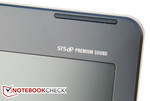
Speakers
HP boasts that this notebook has SRS Premium Sound, which is probably supposed to suggest that a great sound system has been included. SRS Premium Sound is a technology that is supposed to enhance the sound quality using software. It is usually set on its default ‘music’ setting. On this setting, the software adds some reverberation to the music and thus emphasises the higher tones. The software also overamplifies almost all the high tones, so that you can only enjoy music if the volume is set at the halfway point. Playing with the settings brought practically no improvement, and the best result by far was when we turned off audio enhancement.
The speakers are loud enough that you could watch the occasional film using a projector without external loudspeakers. But you should not expect too much of them; with this notebook you have to do completely without bass.
Battery Life
Compared to notebooks with Nvidia’s Optimus system, the HP ProBook 4730s has the disadvantage that its AMD Radeon HD 6490M does not automatically switch off for low performance when in idle mode. Cards like the Nvidia GeForce GT 540M switch themselves off in idle, letting the Intel HD Graphics 3000 integrated into the processor do the work for them. So the ProBook does not measure up as well in idle, needing at least 12 Watts; notebooks with Optimus technology or without a dedicated graphics card come in at under 9 Watts. With heavier use, the notebook’s energy usage is about average, a few Watts below the competitors with an Nvidia GeForce GT 540M.
| Off / Standby | |
| Idle | |
| Load |
|
Key:
min: | |
The lithium ion battery is equipped with a generous 73 Wh capacity, and is recharged using a 540 g, 90 W mains adaptor. To completely recharge the battery requires about 114 mins, i.e. just under two hours.
The Battery Eater Reader’s test simulates the reading of a .txt file, using this to determine the maximum battery life you can expect. The ProBook managed a modest six and a half hours, showing again the high energy consumption during idle use.
The battery life for wireless internet use is determined with a realistic internet surfing test, away from mains power. The notebook lasted for 220 mins, making it perfectly suitable for a short train journey or a car ride. But for anything longer you will have to return to the wall socket.
In the DVD test, a video DVD is played at full brightness. In this test the ProBook only lasted 150 mins. So most films can still be watched while on the go. However, really long films, like Lord of the Rings 3 or The Green Mile, should be watched within reach of mains power to avoid interruptions.
With heavy use, the ProBook survives for a mediocre 84 mins. This result is given by the Battery Eater Classic test, which renders a varying battery in real-time.
Verdict
The HP ProBook 4730s-LH335EA/LH343EA is a stylish, 17.3-inch notebook with modern hardware. The case, mostly consisting of aluminium and matt plastic, is robust and well made. The only issue is the display lid which could be a little more rigid. One positive thing that we noticed was the notebook’s large access panel, making it simple to perform upgrades.
HP could easily have been a little more generous with the range of ports, as there is plenty of spare room on the laptop. But it opted not to include technology for rapid access to external storage media, such as USB 3.0 or eSATA. Also, the ports are all bunched together very inconveniently towards the front of the notebook.
While the keyboard is very good for typing, the touchpad is imprecise and sometimes jumps.
The display is matt, but other than that it is fairly sub-par, with poor viewing angles and weak contrast. A higher maximum brightness would also be preferable for outdoor use.
The performance of the hardware is at the upper end of the mid-range, unable to lift itself from the mass of other notebooks with similar hardware. The dedicated AMD graphics card is also dispensable in a business notebook, especially since it is really too weak for gamers.
The fan runs continually and at a constant speed, so it is not disturbing; nor are the generally acceptable surface temperatures. With the dedicated graphics card the energy use in idle is pretty high, but the large 73 Wh battery still helps the ProBook to good battery run-times.
To sum up, the notebook can be recommended to all private consumers and to business folk who also use their notebook privately. If you don’t expect any major business features, you will find the HP ProBook 4730s-LH335EA/LH343EA to be a reasonably priced notebook which allows you to complete office tasks, as well as edit your holiday videos or play undemanding computer games.





